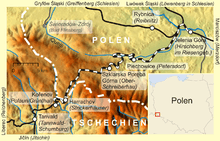Izera railway
Izera railway (Polish: Kolej Izerska, German: Zackenbahn) is a line connecting the Polish town of Jelenia Góra (Hirschberg) with Szklarska Poręba (Schreiberhau). It is part of the former Prussian Zackenbahn,[1] that used to connect Prussia with the Austro-Hungarian Empire via the New World Pass.[2] The line is currently operated by PKP.

History
The name comes from Jizera Mountains. The first section at the foothills of the Giant Mountains (Riesengebirge/Karkonosze/Krkonoše) was completed in 1891. The mountain section took several more years to finish. The railway station Jakobsthal (Jakuszyce) close to the New World Pass became the highest railway station in Prussia. The terminal station was Polaun/Grünthal (Kořenov). The complete track was opened in 1902, together with the Cog railway Tannwald-Grünthal. The line was electrified in 1923.
In April 1945 most of the locomotives were evacuated. Some were captured in the border station Polaun/Grünthal by the advancing Red Army. After the war, the electric equipment was dismantled and together with the remaining locomotives transported to the Soviet Union as reparation. Silesia was transferred to Poland, and cross-border traffic was abolished. Following an exchange of border territories between Czechoslovakia and Poland, the Bohemian part was extended to Harrachov, and that became the new terminal station.
Polish State Railways (PKP) operated passenger trains as far as Szklarska Poręba Huta (Josephinenhütte) and freight trains as far as Jakuszyce. The track as far as Szklarska Poręba Górna was electrified again in 1987. Except for a one-day celebration on the 100th anniversary in 2002, cross border traffic was never restored. Due to decision of the Common Monitoring Committee of Operational Programme of European Transborder Cooperation Czech Republic - Poland 2007-2013 the execution of the project "Revitalization of the Railway Line Szklarska Poreba - Harrachov" will be provided. This project has been recommended to be awarded a subsidy. The reconstruction work started in June 2009 on the Polish side, in October 2009 also on the Czech side. The regular public rail transport across the border started on August 28, 2010. Until December 12, 2015, the trains were operated both by a Polish company Przewozy Regionalne and a Czech company Viamont A.S. (later GW Train Regio), now they are operated both by Polish company Koleje Dolnośląskie and České dráhy.
Some believe the section between Szklarska Poręba Górna and Harrachov would be an ideal location for a steam locomotive scenic railway.
See also
Notes
- Zackenbahn named after the Zacken river (Polish: Kamienna), a tributary to the Bober (Polish: Bóbr) river. Before 1945 the name Isergebirgsbahn was used for the railway line Friedeberg am Queis (Mirsk) - Bad Flinsberg (Świeradów-Zdrój)
- Czech: Novosvětský průsmyk, German: Neuweltpass
External links